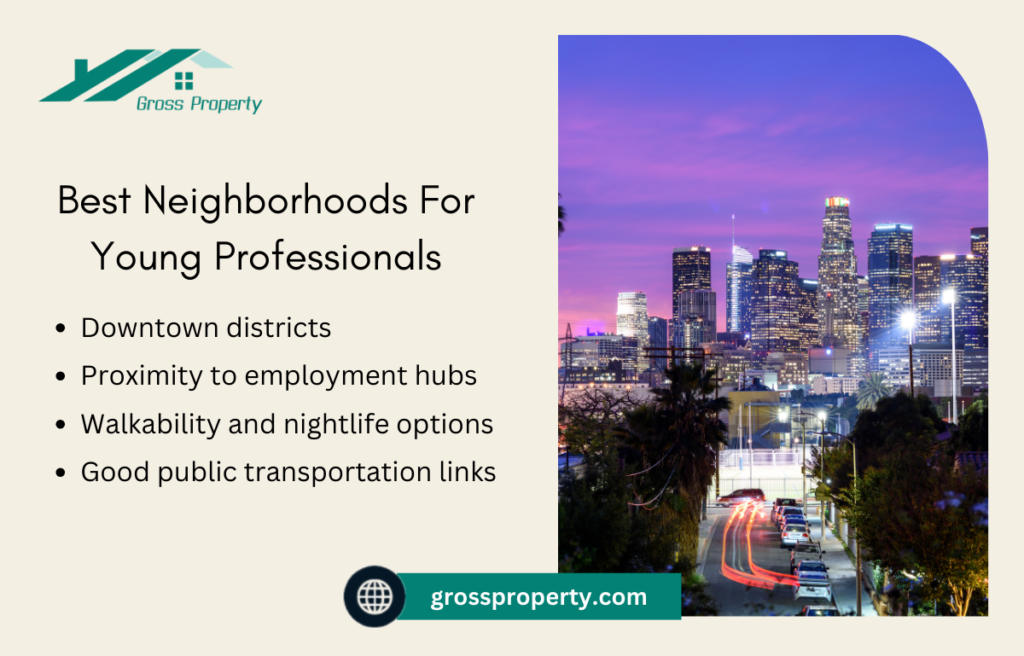Finding the best neighborhoods is a crucial decision when it comes to choosing where to live. Whether you’re looking for a quiet suburban setting, a vibrant city area, or a family-friendly community, the right neighborhood can significantly impact your quality of life. Factors such as safety, access to good schools, proximity to amenities, and real estate market trends are essential to consider when making this decision.
This guide will explore key aspects to help you identify the best neighborhoods that match your preferences and needs. Whether you’re a young professional seeking a lively area, a family looking for top schools, or someone prioritizing affordability, our insights will guide you in making an informed choice.
What are the best neighborhoods for young professionals?
For young professionals, the best neighborhoods often combine proximity to employment hubs with vibrant social scenes and modern amenities. Areas like downtown districts or those near tech and corporate offices typically offer a blend of convenience and lifestyle. Look for neighborhoods with good public transportation links, co-working spaces, and trendy restaurants or cafes, which cater to a fast-paced work life.
Additionally, many young professionals prefer areas with walkability and nightlife options, where everything from grocery stores to entertainment is within a short distance. Areas like Capitol Hill in Seattle or Brooklyn in New York are known for being social and professional hotspots that provide easy access to both work and leisure.

Which neighborhoods are ideal for families?
For families, the best neighborhoods are often those with top-rated schools, safe environments, and access to family-friendly amenities like parks and playgrounds. Suburban areas or neighborhoods with good school districts are typically more attractive to families. Factors such as low crime rates, quiet streets, and community-focused facilities—such as recreational centers and libraries—contribute to the family-friendliness of an area. Neighborhoods that offer a balance of green spaces and a strong sense of community are also appealing for families. Areas like Issaquah in Seattle or Palo Alto in California are examples where education, safety, and community events are prioritized, making them ideal for raising children.
How can you assess a neighborhood’s real estate market trends?
To assess a neighborhood’s real estate market trends, start by reviewing key market indicators such as property value trends, days on market (DOM), and average sale prices. Websites like Realtor.com, Redfin, and Zillow provide up-to-date housing data, helping you understand whether prices are increasing or decreasing over time. Look for patterns in price appreciation and inventory levels, which can indicate whether a neighborhood is in high demand or facing declining interest.
Another useful tool is local market reports from sources like the National Association of Realtors (NAR), which provide insights into the neighborhood’s market health. Reports often include metrics like the ratio of list price to sale price, which reflects the competitiveness of the market. Additionally, checking rental trends in the neighborhood can give you a broader understanding of the area’s overall desirability.
What are the most affordable neighborhoods in major cities?
In large metropolitan areas, affordability is often a key concern for homebuyers. Neighborhoods such as South Boulevard-Park Row Historic in Dallas and San Juan Gardens in San Antonio are known for offering lower housing costs while still providing access to amenities and a suburban lifestyle. In cities like Phoenix, neighborhoods like Central City and South Mountain offer homes below the city’s median price, making them attractive for budget-conscious buyers.
When considering affordable areas, it’s important to look beyond just housing prices. Factors such as proximity to public transportation, availability of local amenities, and community safety also play important roles in determining the true value of a neighborhood.
What are the top factors to consider when choosing the best neighborhoods?
When choosing the best neighborhoods, several factors play a key role in determining whether the area fits your lifestyle and preferences. First, proximity to work, schools, and essential services is crucial. A neighborhood’s location can significantly impact your daily commute, access to education, and convenience for day-to-day needs. Living close to these amenities can save time and improve your overall quality of life.
Another critical factor is safety. Evaluating crime statistics and trends is essential to ensuring peace of mind in your future home. Many neighborhoods offer crime reports, and online platforms can provide reviews from residents that reflect the area’s safety. Lastly, consider the local amenities available in the neighborhood, such as parks, restaurants, healthcare facilities, and recreational centers. These amenities add to the vibrancy and convenience of a neighborhood, making it a more desirable place to live.
How do you determine a neighborhood’s safety and crime rates?
To determine a neighborhood’s safety, start by reviewing local crime statistics. Many municipalities provide access to crime data on official websites, or you can use third-party tools like NeighborhoodScout or CrimeReports to analyze crime trends in a particular area.These tools allow you to check for types of crime, such as property crimes or violent crimes, and compare different neighborhoods.
Additionally, you can look at resident reviews and community feedback. Websites like Niche and Areavibes often have reviews from people living in the area, providing insight into how safe residents feel. These reviews can be particularly helpful in evaluating safety at different times of the day or in different parts of the neighborhood. Finally, visit the neighborhood at various times to get a sense of its security and activity levels during the day and at night.
Which neighborhoods offer the best schools and educational opportunities?
When selecting a neighborhood based on educational opportunities, start by looking at the school district ratings. Websites like GreatSchools or SchoolDigger provide rankings and reviews of schools based on factors such as test scores, student-to-teacher ratios, and college readiness.. Choosing a neighborhood in a highly-rated school district can have a positive impact on your child’s education and future opportunities.
Additionally, consider the proximity of schools to your home. Living near well-regarded public or private schools can reduce commute times and improve your overall quality of life. Finally, don’t overlook extracurricular opportunities in the area. Check if the schools or local community centers offer programs like sports, arts, and music that can enrich your child’s education beyond the classroom
What amenities should you look for in a neighborhood?
When selecting a neighborhood, amenities play a crucial role in enhancing your quality of life. Look for proximity to essential services, such as grocery stores, healthcare facilities, and schools, as these conveniences make daily life more manageable. Access to public transportation is also important, especially in urban areas where commute times can affect your day-to-day activities.
Other desirable amenities include parks, recreational centers, and entertainment options like restaurants and cafes. These amenities foster community interaction and contribute to a neighborhood’s vibrancy. Additionally, check for fitness centers, walking trails, and green spaces, which promote a healthy and active lifestyle. Choosing a neighborhood with a variety of amenities can increase not only your comfort but also the long-term value of your property.
Which neighborhoods offer the best parks and outdoor spaces?
Neighborhoods with abundant parks and outdoor spaces are highly sought after for their recreational opportunities and scenic beauty. To find such neighborhoods, explore areas known for their green spaces and public parks. For instance, neighborhoods like Wallingford and Capitol Hill in Seattle are celebrated for their access to parks like Gas Works Park and Volunteer Park, which offer residents ample space for outdoor activities and relaxation.
In suburban areas, look for neighborhoods with large community parks or nearby nature reserves. These provide not only opportunities for physical activities but also contribute to a peaceful environment. Additionally, many neighborhoods with high walkability scores also feature well-maintained trails and bike paths, making them ideal for outdoor enthusiasts.
How does commute time impact best neighborhoods selection?
Commute time is a major factor when selecting a neighborhood, particularly for those who need to travel daily for work or school. Long commute times can negatively affect your well-being, as extended hours in traffic can lead to increased stress and reduced time for personal activities. When evaluating neighborhoods, consider how proximity to your workplace or access to efficient public transportation systems could reduce your overall commute. Neighborhoods closer to major job centers often have higher housing prices, but they save time and offer a better work-life balance.
Additionally, areas with multiple commuting options—such as bus, train, or bike paths—provide flexibility, especially in cities with traffic congestion. Access to reliable transportation may also influence your decision, making certain neighborhoods more appealing based on convenience and accessibility.
Which are the most walkable neighborhoods in your city?
Walkable neighborhoods are highly sought after for their convenience and accessibility. These areas often feature sidewalks, parks, and public transportation within short distances, allowing residents to complete daily tasks without relying on cars. In cities like Seattle, neighborhoods such as Capitol Hill and Belltown are known for their high walkability, offering easy access to grocery stores, cafes, and entertainment options.
Walkable neighborhoods also tend to promote healthier lifestyles by encouraging residents to walk or bike rather than drive. These areas are ideal for young professionals and families who prioritize access to amenities like schools, parks, and cultural venues, all within a convenient distance.
How can local culture influence your choice of neighborhood?
Local culture is a significant factor that can shape your neighborhood experience. In areas like Barrio Logan in San Diego, for instance, the neighborhood’s rich cultural heritage and artistic community can create a vibrant, engaging environment for residents. Choosing a neighborhood with a strong cultural identity often means more community events, diverse dining options, and a unique atmosphere.
Additionally, neighborhoods with a well-established cultural scene may offer more opportunities for socializing and community involvement. Whether it’s through local festivals, art galleries, or cultural centers, these neighborhoods can enhance your quality of life by providing a sense of connection and belonging.
What tools and resources can help you research best neighborhoods?
When researching best neighborhoods, using online tools is essential for gathering data and insights. Websites like Zillow and Realtor.com provide detailed information on housing prices, trends, and neighborhood amenities. You can also use platforms like Niche and NeighborhoodScout to analyze crime rates, school quality, and resident reviews.
Additionally, geographic tools such as Google Maps and Walk Score can help assess walkability and access to public transportation. For those seeking more specific data, local government websites often provide real-time information on infrastructure development, public services, and neighborhood safety, making them valuable resources in your decision-making process.

What role do community reviews play in selecting a neighborhood?
Community reviews play a significant role in helping prospective residents make informed decisions about best neighborhoods. They offer first-hand insights into the day-to-day living experiences, covering aspects like safety, amenities, and social cohesion. Platforms like Nextdoor and Niche often feature detailed reviews from current or former residents, which highlight both the positives and potential drawbacks of living in certain areas.
Additionally, these reviews often mention local engagement, such as community events, volunteer efforts, and neighborhood associations, which are key indicators of how vibrant and supportive a community might be. By considering these reviews, potential buyers can gain a better understanding of whether a neighborhood aligns with their lifestyle and preferences.
How do future development plans affect neighborhood desirability?
Future development plans can significantly enhance a neighborhood’s desirability by improving infrastructure, amenities, and economic opportunities. Projects like new transportation links, road improvements, and the introduction of commercial centers can make a neighborhood more accessible and convenient. These developments often lead to a rise in property values, as residents and investors anticipate long-term growth and enhanced quality of life.
For example, the construction of new schools, parks, or shopping areas not only boosts local amenities but also fosters community engagement. Future growth can make a neighborhood more attractive to families and professionals alike, as these changes often translate into better living conditions and a more vibrant social environment.
Selecting the best neighborhood is an essential part of finding the perfect home. From considering safety, access to quality schools, and proximity to amenities, each factor plays a critical role in determining your overall living experience. Understanding future development plans and evaluating the local culture further help you ensure that your neighborhood will meet both your immediate needs and long-term aspirations.
Whether you’re a seasoned homeowner or a first-timehome buyer, taking the time to thoroughly research and assess each neighborhood will provide confidence in your decision, leading to a satisfying and prosperous living environment. With the right tools, such as community reviews and online platforms, you can find best neighborhoods that align with your lifestyle and investment goals.











